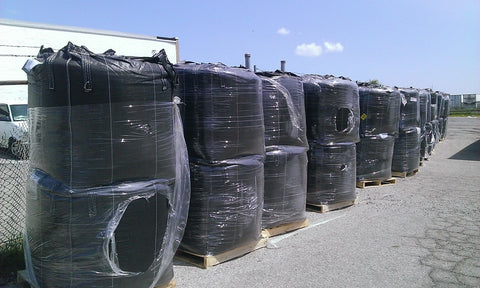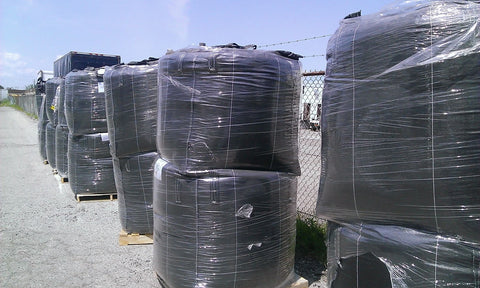News
Index of Radon February 19 2022, 18 Comments
Radon test results
What you do depends on how much radon there is. Radon is measured in becquerels per cubic metre (Bq/m3).
- If your home’s radon level is less than 200 Bq/m3, Health Canada radon guidelines say that no action is required. However, even low levels of radon can be harmful. It’s a good idea to try to lower your home’s radon level as much as possible, even if it’s already below 200 Bq/m3.
- If your home’s radon level is between 200 and 600 Bq/m3, you should repair your home in the next two years.
- If your home’s radon level is over 600 Bq/m3, you should repair your home within one year.
Reduce radon levels in your home
To lower the radon level, you need to hire a contractor to:
- Figure out where the radon is coming in
- Complete repairs to block it from coming in
Radon can come into your home through: sump pumps, cracks in foundations, spaces around pipes, unfinished floors, and other places. To solve your radon problem, you need an expert to find out where exactly the radon is getting in. A trained contractor with experience in radon mitigation (radon repairs) can examine your home, find where the radon is seeping in, and make the necessary repairs.
If you smoke and have been exposed to higher levels of radon, it’s very important to try to quit smoking. The combined effects of cigarette smoking and radon exposure raise the risk of lung cancer much more than either exposure alone.
Be aware of possible symptoms of lung cancer, such as shortness of breath, a new or worsening cough, pain or tightness in the chest, hoarseness, or trouble swallowing, and tell your doctor if you start to have any of these symptoms.
For uranium miners, millers, and transporters who have certain health problems as a result of exposure to radon, the United States government has established the Radiation Exposure Compensation Program.
The Activated Carbon Fiber can absorb Radon Gas.
Our Electrostatic Filter Air Purifier has more efficiency to remove radon gas.
Lignite coal based PAC with very lower ash content and best performance in waster water treatment February 12 2019, 13 Comments

We shipped 10MT lignite coal based PAC with very lower ash content (<15%) and higher index in Methylene Blue (>90%) to Canada market at beginning of 2019.
So the carbon will have higher performance in waster treatment to remove the odors and metals.
Activated Carbon for Auto industrial February 12 2019, 4 Comments

There are waster water in auto industrial. This carbon is good on for auto industrial to treat the waster water. We supply the carbon by bulk bags with discharge at button.
The is a new shipment arrived in warehouse in Jan 2019.
More Activated carbon delivery to our clients July 10 2015, 12 Comments



We have shipped more activated cabon to our client in Toronto. The 3rd picture is carbon loading into the container at Port of Tianjing, China. The 1st and 2nd pictures is carbon unloading on ground in Toronto, Canada. The condition of bulk bag packaging is perfect.
Activated Carbon Toothpaste February 27 2015, 3 Comments

The activated carbon power toothpaste is making your teeth shining, and removing the smell in your mouth. It is the new application for the carbon in personal health care.
More odor removal filter bags are loading into the container to ship to Canada April 04 2014, 4 Comments
More activated carbon for odor removal filter bags are shipping from manufacturer.


Carbon is shipping to Toronto, Canada April 04 2014, 8 Comments
The carbon bulk bags are loading into a 40 feet container at the port.
The weight of bulk bag is 500kg. This is a GAC8x30 acid washed activated carbon shipping to Toronto on April 3rd.



Photos for loading activated carbon into the 40 feet container April 04 2014, 4 Comments
Our another full 40 feet container is shipping to Montreal, Canada today.
There are 44 bulk bags (550kg/bag) of 3.0mm coconut shell based activated carbon.





The History of Activated Carbon February 09 2014, 4 Comments
THE HISTORY OF ACTIVATED CARBON
The exact date and time that man began using activated carbon or charcoal is lost to history. However, there is evidence of its usage and importance throughout history, from the ancient world to the modern era.
or charcoal is lost to history. However, there is evidence of its usage and importance throughout history, from the ancient world to the modern era.
ANCIENT WORLD
Around 3750 B.C., the Ancient Egyptians made use of charcoal to smelt ores to create bronze. By 1500 B.C., according to the first documented use of charcoal as written on papyrus, the Egyptians’ use of charcoal had progressed, using the material to absorb unpleasant odors, cure intestinal ailments and even preserve the dead.
In 400 B.C., the Ancient Hindus and Phoenicians had started using charcoal to purify water because of its antiseptic properties. The Phoenicians were noted for charring barrels to hold water on long sea voyages. This practice was adopted by many other seafarers throughout history, including Christopher Columbus, and continued until the 1800s.
By 50 A.D, Hippocrates, one of the most historic figures in the history of medicine started using charcoal for a number of medical purposes, including treating epilepsy, chlorosis and vertigo. By 2 A.D., another important figure in medical history, Claudius Galen produced almost 500 treatises on the use of charcoal in medicine.
1700'S
Though charcoal was in steady use throughout the centuries, it made a strong resurgence in the late 1700s. More doctors, chemists and other scientific figures began experimenting with the material for both medical and manufacturing processes. In 1773, chemist Carl Wilhelm Scheele quantified the adsorption forces for porous carbon by measuring the volume of gases adsorbed by the material. In 1776, Lowitz performed the first experiments that proved that carbon could be used to decolor solutions, noting the adsorptive properties of charcoal in liquid phase.
One of the biggest discoveries in this period, however, was in 1794, when an English sugar refinery found that carbon could be used as a decoloring agent. This revolutionized the sugar industry, which was looking for a way to produce a whiter, more appealing product. In turn, this development pushed the experimentation of activated carbon further. By 1805 all of Europe was using charcoal to decolor sugar.
further. By 1805 all of Europe was using charcoal to decolor sugar.
1800'S
Charcoal continued to be a strong force in the 19th century, especially in medicine. It was used for poultices, sloughing ulcers and treating gangrenous sores. After the activated carbon process was developed around 1820, it became noted in medical journals as an antidote for poison and a treatment for intestinal disorders. In 1883, French chemist, Gabriel Bertrand, in an effort to prove charcoal’s worth as a poison treatment, swallowed arsenic mixed with charcoal. Others followed suit and performed the same trick.
process was developed around 1820, it became noted in medical journals as an antidote for poison and a treatment for intestinal disorders. In 1883, French chemist, Gabriel Bertrand, in an effort to prove charcoal’s worth as a poison treatment, swallowed arsenic mixed with charcoal. Others followed suit and performed the same trick.
In 1862, Frederick Lipscombe helped pave the way for commercial applications ofactivated carbon by using the material to purify potable water. German physicist, Heinrich Kayser, coined the term “adsorption” to describe charcoal’s ability to uptake gases in 1881.
by using the material to purify potable water. German physicist, Heinrich Kayser, coined the term “adsorption” to describe charcoal’s ability to uptake gases in 1881.
THE 20TH CENTURY
Activated carbon was first produced on an industrial scale at the beginning of the twentieth century. In 1909 a plant named “Chemische Werke” was built to manufacture carbon for commercial use, producing various carbon such as Eponit, Purit, Norit and Calgon The Norit Company, a manufacturer in Holland, was started in 1911 and became widely known in the sugar industry for their powdered solutions, widely used in the chemical and food industries for decolorization.
was first produced on an industrial scale at the beginning of the twentieth century. In 1909 a plant named “Chemische Werke” was built to manufacture carbon for commercial use, producing various carbon such as Eponit, Purit, Norit and Calgon The Norit Company, a manufacturer in Holland, was started in 1911 and became widely known in the sugar industry for their powdered solutions, widely used in the chemical and food industries for decolorization.
During World War I activated carbon was used in gas masks worn by American soldiers to protect them from poison gas. This development led to the production of granular carbon on a large scale.
was used in gas masks worn by American soldiers to protect them from poison gas. This development led to the production of granular carbon on a large scale.
ACTIVATED CARBON TODAY
Today, the uses of activated carbon continue to grow. It can be found in virtually every hospital, clinic or doctor’s office in the world, used on almost a daily basis. The material is used in a variety of industries, including corn and cane sugar refining, gas adsorption, dry cleaning, pharmaceuticals, fat and oil removal, alcoholic beverage production and much more. The biggest market for activated carbon is in the purification of municipal water supplies. Activated carbon filters are used in water treatment to remove organic compounds that produce carcinogens during the disinfection of water. The second biggest market for activated carbon is removal of heavy metals in the coal fire powder plants in USA and Canada from 2014.
continue to grow. It can be found in virtually every hospital, clinic or doctor’s office in the world, used on almost a daily basis. The material is used in a variety of industries, including corn and cane sugar refining, gas adsorption, dry cleaning, pharmaceuticals, fat and oil removal, alcoholic beverage production and much more. The biggest market for activated carbon is in the purification of municipal water supplies. Activated carbon filters are used in water treatment to remove organic compounds that produce carcinogens during the disinfection of water. The second biggest market for activated carbon is removal of heavy metals in the coal fire powder plants in USA and Canada from 2014.
The new market for activated carbon is for home use to remove the odor to keep air plash.
Get a Free 100 Packs Coconut Shell Based Activated Carbon Odor Absorber Box for your new condo unit at ICON330! November 22 2013, 81 Comments
You will receive our a free 100 packs Odor Absorber Box if you buy an unit of ICON330 condo from Mr. Kevin Zhao, sales representative. This ICON330 condo is located across the street from the University of Waterloo and close proximity to Wilfred Laurier University. The occupancy date is Sept., 1st, 2014. Our Odor Absorber is the free give for the new owner of the codon. There is no odor in the house when you move in. This is the first condo using our activated carbon as free gift to the buyer in Canada.
For more information about the ICON330, please looking at following website:
There is a sales presentation:
Address: 95 Duffield Drive Markham Ontario.
Date: Dec. 6th, 2013
Time: 11:00AM - 4:00 PM
Please feel free to contact me if you have any question or want to buy the condo unit.
Rodger LU
Cell: 647-286-8419
Coal based activated carbon May 09 2013, 8 Comments
Coal based activated carbon originates from coal that has undergone a steam activation process. During activation,millions of pores are created on the surface of the carbon, increasing the total surface area. Coal based carbon has mainly meso-pores and macro-pores and due to its unique distribution of pore diameter, coal based activated carbon is very popular in gas phase purification, potable water purification, wastewater purification and aquarium/pond water purification applications.
1. Bituminous coal based activated carbon
2. Anthracite coal based activated carbon
3. Lignite coal based activated carbon
What is the Activated Carbon? May 09 2013, 6 Comments
What is the Activated Carbon?
The primary raw material used for activated carbon is any organic material with a high carbon content (coal, wood, peat, coconut shells). Granular activated carbon media is most commonly produced by grinding the raw material, adding a suitable binder to give it hardness, re-compacting and crushing to the correct size.
The carbon-based material is converted to activated carbon by thermal decomposition in a furnace using a controlled atmosphere and heat. The resultant product has an incredibly large surface area per unit volume, and a network of submicroscopic pores where adsorption takes place.
The walls of the pores provide the surface layer molecules essential for adsorption. Amazingly, one pound of carbon (a quart container) provides a surface area equivalent to six football fields
What is the Particle Size of Activated Carbon?
Activated carbon is a carbonaceous adsorbent with a high internal porosity, and hence a large internal surface area. Commercial activated carbon grades have an internal surface area of 500 up to 1500 m2/g. Related to the type of application, three major product groups exist:
- Powdered activated carbon; particle size 1-150 μm
- Granular activated carbon, particle size 0.5-4 mm
- Extruded activated carbon, partilce size 0.8-4 mm
What is the type of internal pores?
A proper activated carbon has a number of unique characteristics: a large internal surface area, dedicated (surface) chemical properties and good accessibility of internal pores. According to IUPAC definitions three groups of pores are distinguished:
- Macropores (> 50 nm diameter)
- Mesopores (2-50 nm diameter)
- Micropores (< 2 nm diameter)

Micropores generally contribute to the major part of the internal surface area. Macro and mesopores can generally be regarded as the highways into the carbon particle, and are crucial for kinetics. Macropores can be visualised using scanning electron microscopy. The pore size distribution is highly important for the practical application; the best fit depends on the compounds of interest, the matrix (gas, liquid) and treatment conditions.
The desired pore structure of an activated carbon product is attained by combining the right raw material and activation conditions.
